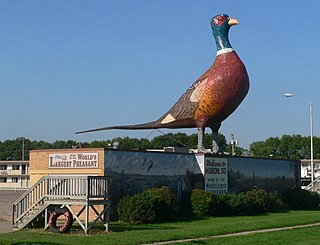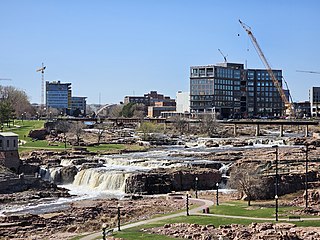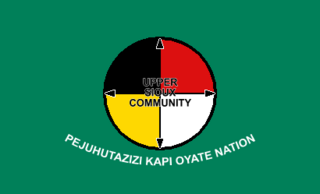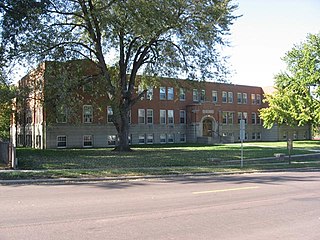
South Dakota is a U.S. state in the North Central region of the United States. It is also part of the Great Plains. South Dakota is named after the Dakota Sioux Native American tribe, which comprises a large portion of the population with nine reservations currently in the state and have historically dominated the territory. South Dakota is the 17th largest by area, but the 5th least populous, and the 5th least densely populated of the 50 United States. As the southern part of the former Dakota Territory, South Dakota became a state on November 2, 1889, simultaneously with North Dakota. They are the 39th and 40th states admitted to the union; President Benjamin Harrison shuffled the statehood papers before signing them so that no one could tell which became a state first. Pierre is the state capital, and Sioux Falls, with a population of about 192,200, is South Dakota's most populous city.

Huron is a city in Beadle County, South Dakota, United States. It is the county seat of Beadle County. The population was 14,263 at the 2020 census, and it is the 8th most populous city in South Dakota.

Harrisburg is a city in Lincoln County, South Dakota, United States and is a suburb of Sioux Falls. The population was 6,732 at the 2020 census.

Sioux Falls is the most populous city in the U.S. state of South Dakota and the 121st-most populous city in the United States. It is the county seat of Minnehaha County and also extends into Lincoln County to the south, which continues up to the Iowa state line. As of 2022, Sioux Falls had an estimated population of 202,078. The Sioux Falls metro area accounts for more than 30% of the state's population. Chartered in 1856 on the banks of the Big Sioux River, the city is situated in the rolling hills at the junction of interstates 29 and 90.
Prairie City is an unincorporated community and census-designated place in Perkins County, South Dakota, United States. One of many rural settlements in Perkins County, the town was founded in 1946 by former residents of Strool. The population of the CDP was 25 at the 2020 census.

The Lower Sioux Indian Community, also known as the Mdewakanton Tribal Reservation, is an Indian reservation located along the southern bank of the Minnesota River in Paxton and Sherman townships in Redwood County, Minnesota. Its administrative headquarters is two miles south of Morton. The reservation is located southeast of Redwood Falls, the county seat.

The Upper Sioux Indian Reservation, or Pezihutazizi in Dakota, is the reservation of the Upper Sioux Community, a federally recognized tribe of the Dakota people, that includes the Mdewakanton.

Interstate 229 (I-229) is an auxiliary Interstate Highway located entirely within Sioux Falls, South Dakota, United States. It runs for approximately 11 miles (18 km) around the southern and eastern sides of the city, providing a bypass route and connecting I-29 and I-90. The freeway is generally four-to-six lanes wide and follows the Big Sioux River through parts of the city. I-229 also has a business route that provides access to downtown Sioux Falls from the freeway.

KELO-TV is a television station in Sioux Falls, South Dakota, United States, affiliated with CBS and MyNetworkTV. The station is owned by Nexstar Media Group, and maintains studios on Phillips Avenue in downtown Sioux Falls; its transmitter is located near Rowena, South Dakota. KELO-TV is broadcast by three high-power semi-satellites—KDLO-TV in Florence, KPLO-TV in Reliance, and KCLO-TV in Rapid City. These transmitters and others, together branded as the KELOLAND Media Group, broadcast KELO programs to all of South Dakota, southwestern Minnesota, and northwestern Iowa, an area the station calls "KELOLAND".

KDLT-TV is a television station in Sioux Falls, South Dakota, United States, affiliated with NBC and Fox. It is owned by Gray Television alongside ABC/CW+ affiliate KSFY-TV. Both stations share studios in Courthouse Square on 1st Avenue South in Sioux Falls, while KDLT-TV's transmitter is located southeast of the city near Rowena.

Strongfield is a village in the Canadian province of Saskatchewan within the Rural Municipality of Loreburn No. 254 and Census Division No. 11. It lies approximately 100 km south of the City of Saskatoon on Highway 19 between its sister communities of Hawarden and Loreburn.

The history of South Dakota describes the history of the U.S. state of South Dakota over the course of several millennia, from its first inhabitants to the recent issues facing the state.
South Sioux Falls was an incorporated community located in south-central Minnehaha County, South Dakota, United States. It existed from 1890 until 1955. The community was centered in present-day Sioux Falls along Minnesota Avenue, stretching from 33rd Street in the north to 57th Street in the south.
This timeline of South Dakota is a list of events in the history of South Dakota by year.
Zeona is an extinct town in Perkins County, in the U.S. state of South Dakota. The GNIS classifies it as a populated place.
The 1955 South Dakota Coyotes football team was an American football team that represented the University of South Dakota as a member of the North Central Conference (NCC) during the 1955 college football season. In their 17th season under head coach Harry Gamage, the Coyotes compiled a 4–4 record, tied for fifth place out of seven teams in the NCC, and outscored opponents by a total of 191 to 151. They played their home games at Inman Field in Vermillion, South Dakota.
The 1956 South Dakota Coyotes football team was an American football team that represented the University of South Dakota as a member of the North Central Conference (NCC) during the 1956 NCAA College Division football season. In their first season under head coach Ralph Stewart, the Coyotes compiled a 4–4 record, tied for second place out of seven teams in the NCC, and were outscored by a total of 146 to 140. They played their home games at Inman Field in Vermillion, South Dakota.
The 1957 South Dakota Coyotes football team was an American football team that represented the University of South Dakota as a member of the North Central Conference (NCC) during the 1957 NCAA College Division football season. In their second season under head coach Ralph Stewart, the Coyotes compiled a 4–4–1 record, finished in fourth place out of seven teams in the NCC, and were outscored by a total of 146 to 140. They played their home games at Inman Field in Vermillion, South Dakota.

The Presentation Children's Home is a historic building at 701 South Western Avenue in Sioux Falls, South Dakota. Built to replace an earlier orphanage in Turton that burned down, it functioned not only as an orphanage—one of the few in South Dakota—but also as a school from its opening in 1940 to its closure in 1966. It was added to the National Register of Historic Places in 1993.














